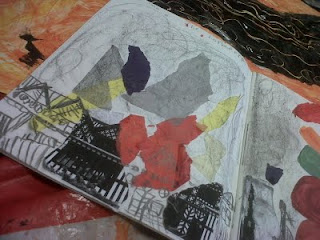This new book provides an exciting insight into how sketchbooks can be used by teachers and students to make significant changes in atitudes to learning. Case studies are included of sketchbooks from artists, designers, architects, scientists and musicians etc. The authors highlight ways in which sketchbooks can be used as a playground for imagination and trialling ideas, as well as encouraging exploration and creative thinking
Think Inside the Sketchbook
Gillian Robinson, Alison Mountain and David Hulston
Published by HarperCollins in association with NSEAD (2011)
At a time when the Government seems hell bent on pushing art and design education to the margins of the school curriculum, it is very good to know that self-help is at hand in the form of Think inside the sketchbook. The authors tell us that sketchbooks and journals are ‘a non-threatening active space for exploration, play, self-evaluation and reflection … tools for gathering evidence, working through trial and error, asking and answering questions … they provide a way of learning which develops children as researchers…This book aims to capture the spirit in which sketchbooks are kept, and offers a number of practical strategies for their implementation.’
Think inside the sketchbook makes very helpful connections between the work of professionals and that of school students. It is a heavily illustrated 96-page A4 book that will be of particular value to educators. It identifies the kinds of thinking that sketchbooks and journals promote, explaining the what, who, why, and how of keeping sketchbooks. It is dominated by the artist’s voice, but also includes examples by designers and other professionals, such as a scientist, mathematician, composer and choreographer. In this particular book, a key challenge was how to bring together so many disparate examples to create what has become a coherent whole. The variety of examples demonstrates the wealth of approaches possible.
The scope of the book is very broad. Sketchbooks are placed in the same category as learning books, thinking books, visual diaries, daybooks and journals; yet particular branding implies different purposes or emphases. The structure is very clear and the argument is supported by many quotes. However, a stronger authorial voice might have been able to make more explicit the kinds of thinking prompted by the different approaches. Because it is primarily an advocacy document, where the intention is to inspire and enthuse, the text does not critique the use of sketchbooks by young people.
The book is a welcome addition to the growing range of publications that throw light on the use of sketchbooks. These include facsimiles of sketchbooks by artists such as Constable, Turner, Picasso, Moore and Gormley. Others, such as Tony O’Malley, The Visual Diaries by Brian Lynch, or The Diary of Frida Kahlo by Sarah Lowe, are edited collections of pages from artists’ and designers’ sketchbooks, with interpretative commentaries to illuminate their use. These feature mainly sketchbooks by adult artists: there are not so many that explore the use of sketchbooks by children and young people. An exception is Lines of Enquiry, published by The Campaign for Drawing, which is specifically about 16-18 year old students’ use of sketchbooks in art and design education. The commentary in Think Inside the Sketchbook is not merely a descriptive narrative, it attempts to explain the purposes that underpin the activities of drawing, collecting, collating, reviewing, reworking and manipulating material and ideas to develop thinking.
Think inside the sketchbook will increase the current interest in sketchbooks and their use. It celebrates and validates young people’s work and illuminates how sketchbooks can be used as a medium for learning and thinking. It presents convincing evidence that will encourage teachers to greater effort, enthusiasm and creativity in the use of sketchbooks – both for themselves and for their students.
Eileen Adams
















































